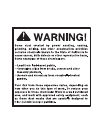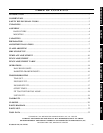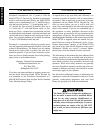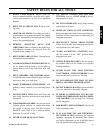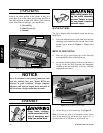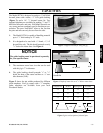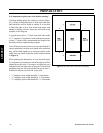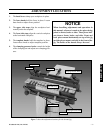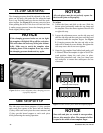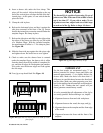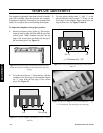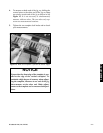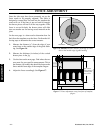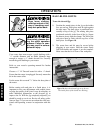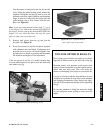
- 8 - Woodstock Intl., Inc. D2796
ADJUSTMENTS
The side stops serve three purposes: (1) they position
each work piece square to the fence and one another,
(2) they offset each work piece the correct amount, and
(3) they provide lateral support to each work piece
while performing the routing operation.
To Adjust:
1. Loosen the fence and slide to the rear. Slide the
drawer piece horizontally under the top clamp and
the template. Place the drawer against either the left
or right side stop.
2. Loosen the adjustment screw on the side stop and
shift the side stop and the work piece until the wood
is centered under the template fingers. See Figure
9. Centering ensures that the pins and tails on the
ends will be identical to one another. Re-tighten the
side stop screws but do not over tighten.
3. Grasp the jig template from behind and gently pull
it forward. When the template is tight in its full for-
ward position, clamp the work piece in place.
Repeat this procedure each time you clamp your
top workpiece to ensure that subsequent cuts are
consistent.
The clamping pressure should be adjusted so the work-
piece can be easily slid under the bar when the hand
lever is up. Push the hand lever down to hold the work-
piece in place. See Figure 8. Do not use excessive force
when pushing the lever. If the lever will not lock firm-
ly under average pressure, loosen the clamping pressure
knobs slightly and try again.
Figure 8 shows correct alignment when clamping pressure
is properly adjusted.
CLAMP ADJUSTING
SIDE STOP SET UP
NOTICE
If the clamping pressure knobs are set too tight,
the template will slightly lift up off the workpiece.
This will reduce the accuracy of the joint dramat-
ically. Make sure to watch the template when
clamping down. If the template flexes up, reduce
the clamping pressure knobs and try again.
NOTICE
All work pieces must be cut perfectly square for
the dovetail joints to fit properly.
Centered Under Template
Figure 9. Center drawer piece under the template fingers.
NOTICE
Since tails and pins are routed in one operation,
drawer sides must be offset. The amount of offset
is equal to the width of one template finger.



